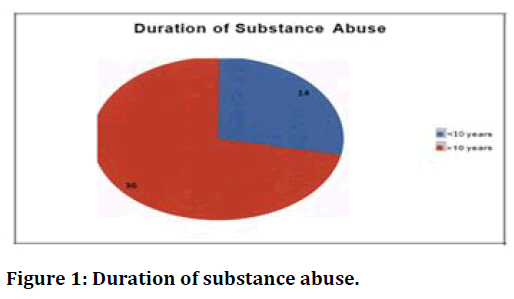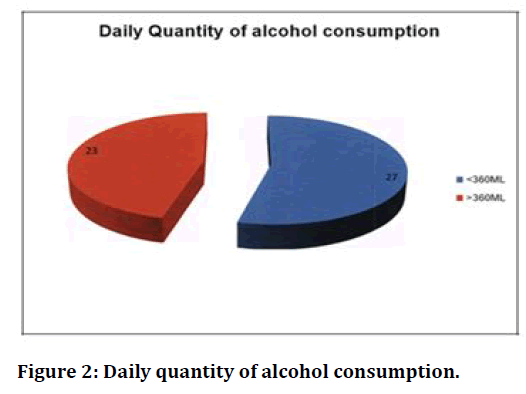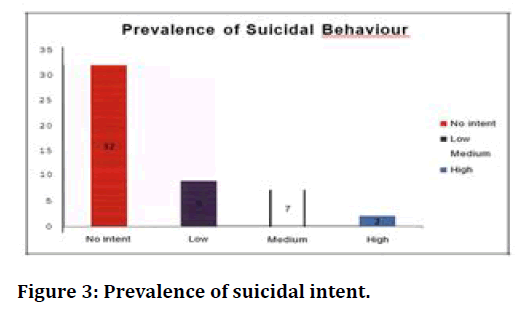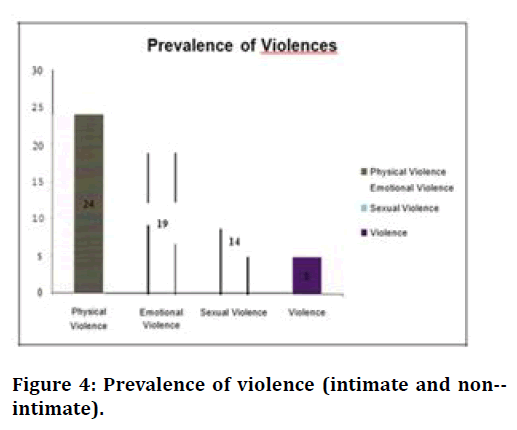Research - (2021) Volume 9, Issue 6
A Study to Assess Hostility, Violence and Suicidal Behaviour in Persons Suffering from Alcohol Dependence Syndrome
*Correspondence: S Nambi, Department of Psychiatry, Sree Balaji Medical College & Hospital Affiliated to Bharath Institute of Higher Education and Research, India, Email:
Abstract
Alcoholism is among the most common psychiatric disorders in our country. Alcohol is a potent drug that causes both acute and chronic changes in almost all neurochemical systems. Thus, alcohol abuse can produce serious temporary psychological symptom including depression, anxiety and psychoses. It is descriptive study, 50 persons suffering from alcohol dependence syndrome along with their relatives were recruited from inpatient department of Psychiatry at Sree Balaji Medical College, Chennai. Inclusion criteria Patients aged 18 to 60 years Diagnosis of alcohol dependence Syndrome as per ICD 10 diagnostic criteria clinically stable for an interview. Exclusion criteria: Patients’ having comorbid substance dependence /mood / psychotic disorders Persons with cognitive deficits/organic mental disorder Patients with delirium tremens during their inpatient stay. Prevalence of suicidal intent, the results showed 64% to have no suicidal intent or ideation. 36% have positive scores for suicidal intent of which 18% has low intent, 14% medium intent and 4% has high intent to commit suicide. Prevalence of violence, In the study group 48% has history of intimate physical violence, 38% has history of intimate emotional violence, 28% has history of intimate sexual violence and 10% has history of non-intimate violence.48% of the study group has low risk of committing violence in the near future.14% has medium risk and 6% has high risk to commit or repeat their act of violence. Conclusion The prevalence of suicidal behaviour is higher among persons suffering from alcohol dependence syndrome .Earlier the age of alcohol abuse higher the intent of suicidal behaviour. Persons who consumes high quantity of alcohol found to have high intent of suicidal behaviour. In this study there is no correlation between duration and quantity of alcohol abuse with domestic violence.
Keywords
Alcohol dependence syndrome, Suicidal behaviour, Psychiatric disorders
Introduction
Globally, alcohol consumption has increased in recent decades, with all or most of that increase is seen in developing countries. Alcohol consumption has health and social consequences via intoxication (drunkenness), dependence (habitual, compulsive and long-term drinking), and biochemical effects. Heavy alcohol use results in loss of many years of life due to disability and death in a relatively young age, in addition to chronic diseases affecting heavy drinkers.
Alcohol is the leading substance among the abused substances which is legal to use and causes considerable burden than any other substances. Alcohol not only harms the health of the drinker but also the wellbeing and health of the peoples around the drinkers including their family. Majority of crimes, suicides, road traffic accidents, divorces are related to alcohol.
Suicide once an escalating public health problem, and alcohol use has been consistently implicated in the precipitation of suicidal behaviour. Alcohol abuse may cause disinhibit ion, impaired judgment and impulsiveness which leads to suicidality. In the last 45 years, suicide rates have increased by about 60% worldwide, with global suicide figures potentially reaching 1.5 million deaths by the year 2020 [1-3].
The focus of this paper is to provide a broad overview of the much-debated relationship between alcohols, suicide, and violence. Suicidal behaviour among alcohol abusers is a matter of great concern, it is vital to study the prevalence of such behaviour among these persons suffering from alcohol dependence syndrome. The study is aimed to assess suicidal behaviour in terms of prevalence and intensity, hostile tendency to harm themselves or to harm others in persons suffering from alcohol dependence syndrome.
Materials and Methods
It is descriptive study, 50 persons suffering from alcohol dependence syndrome along with their relatives were recruited from inpatient department of Psychiatry at Sree Balaji Medical College, Chennai. Inclusion criteria Patients aged 18 to 60 years Diagnosis of alcohol dependece Syndrome as per ICD 10 diagnostic criteria clinically stable for an interview. . Exclusion criteria. Patients’ having comorbid substance dependence / mood /psychotic disorders Persons with cognitive deficits/organic mental disorder Patients with delirium tremens during their inpatient stay. Instruments used for assessment, CAGE Questionnaire, MAST, Beck's suicidal intent scale, Extrapunitive-intropunitive scale (Hostility scale), & Historical Clinical Risk management scale- 20 (HCR 20). 50 persons from inpatient department of psychiatry ward diagnosed to be suffering from alcoholendemic syndrome using ICD-10 and who fulfils the inclusion and exclusion criteria for the study are recruited all with their\ attenders. After obtaining informed consent, their socio demographic, clinical details were collected using the semi structured proforma developed especially for this study. The details were collected during the day of admission and on 4 the day of admission and on the day of discharge.
Results
Socio demographic variables of persons suffering from alcohol dependence (Table 1).
| Variable | Group | Number | % |
|---|---|---|---|
| Education Status | Illiterate | 1 | 2 |
| Primary Education | 20 | 40 | |
| Secondary Education | 20 | 40 | |
| Graduate | 9 | 18 | |
| Occupation | Unemployed | 6 | 12 |
| Semi-Skilled | 33 | 66 | |
| Skilled | 8 | 16 | |
| Professional | 3 | 6 | |
| Marital Status | Single | 5 | 10 |
| Married | 42 | 84 | |
| Separated | 3 | 6 | |
| Age of Onset of Substance Abuse | 15-20 Years | 26 | 52 |
| 21-25 Years | 16 | 32 | |
| 26-30 Years | 8 | 16 | |
| Duration of Substance Abuse | <10 years | 14 | 28 |
| >10 years | 36 | 72 | |
| Daily Quantity of alcohol consumption | <360ML | 27 | 54 |
| >360 ML | 23 | 46 | |
| Family History of Alcohol Abuse | Parents , Siblings | 35 | 70 |
| Grandparents, Uncle Aunts | 4 | 8 | |
| No history | 11 | 22 | |
| Family History of Suicide | Grandparents , Uncle Aunts | 5 | 10 |
| No history | 45 | 90 | |
| History of Intimate Emotional Violence | Present | 19 | 38 |
| Absent | 31 | 62 | |
| History of Intimate Sexual Violence | Present | 14 | 28 |
| Absent | 36 | 72 | |
| History of Violence | Present | 5 | 10 |
| Absent | 45 | 90 | |
| Age Group | 25-35 | 23 | 46 |
| 36-45 | 13 | 26 | |
| 46-58 | 14 | 28 |
Table 1: Syndrome.
Duration of substance abuse
36% of the study participants consumes alcohol for duration of more than 1Oyears, 14% of them consumes alcohol for duration of less than 10 years (Figure 1).

Figure 1. Duration of substance abuse.
Daily quantity of alcohol consumption
Among the study participants 23% consumes less than 360 ml IMFL daily and 27% consumes more than 360ml IMFL daily (Figure 2).

Figure 2. Daily quantity of alcohol consumption.
Prevalence of hostility
EI Scale is used to measure the prevalence and punitiveness of hostility in this study group. All the study participants scored positive for hostile tendency. Further the results showed that around 66% were extropunitive 1.e tendency to harm others and 34% were intropunitive 1.e tendency to harm self.
Prevalence of suicidal intent
Suicidal intent among the study participants were measured using Beck's suicide intent scale. The results showed 64% to have no suicidal intent or ideation. 36% have positive scores for suicidal intent of which 18% has low intent, 14% medium intent and 4% has high intent to commit suicide (Figure 3).

Figure 3. Prevalence of suicidal intent.
Prevalence of violence (intimate and non-intimate)
In the study group 48% has history of intimate physical violence, 38% has history of intimate emotional violence, 28% has history of intimate sexual violence and 10% has history of non-intimate violence (Figure 4). Table 2 shows Association of BECK'S Suicidal intent scale with other variables.

Figure 4. Prevalence of violence (intimate and non--intimate).
| Variable | Group | BECK'S Suicidal intent | P-value | |||
|---|---|---|---|---|---|---|
| No intent | Low | Medium | High | |||
| Age Group | 25 -3 5 | 15 (46.9%) | 3 (33 .3%) | 5 (71.4%) | 0 | 0.1 37 |
| 36-45 | 9 (28. l %) | 4 (44.4%) | 0 | 0 | ||
| 46-58 | 8 (25%) | 2 (22.2%) | 2 (28.6%) | 2 | ||
| Duration of substance abuse | <l 0 years | 9 (28.1%) | 1 (11.1%) | 4 (57.1%) | 0 | 0. 1 72 |
| > 10 years | 23 (71.9%) | 8 (88.9%) | 3 (42.9%) | 2 (1 00 %) | ||
| Daily quantity of alcohol consumption | <360 ml | 17 ( 53 . 1 %) | 4 (44.4 %) | 6 (85.7%) | 0 | 0. 1 37 |
| >360 ml | 15 (46.9%) | 5 (55.6%) | l (14.3%) | 2 (100%) | ||
| Age of onset of substance abuse | 15-20years | 14 (43.8%) | 6 (66.7 %) | 4 (57.1%) | 2 (100%) | 0. 735 |
| 21-25 years | 12 (37.5%) | 2 ( 22 . 2% ) | 2 (28.6%) | 0 | ||
| 26-30 years | 6 ( 1 8.8% ) | 1 (11.1%) | l (14.3%) | 0 | ||
| Marital S ta tu s | Single | 4 ( 12. 5%) | 0 | l (1 4.3% ) | 0 | 0. 733 |
| Married | 25 (78.1%) | 9 (1 00 %) | 6 (85.7%) | 2(100%) | ||
| Separated | 3 (9.4%) | 0 | 0 | 0 | ||
| EI Scale | Extropunitive | 31 (96.9%) | 2 (22.2% ) | 0 | 0 | 0 |
| Intrapunitive | 1 (3.1%) | 7 (77.8%) | 7 (100%) | 2 (100%) | ||
Table 2: Association of BECK'S Suicidal intent scale with other variables.
Chi square
There 1s significant association between the hostility score and suicidal behaviour in the study group. It is also found that suicidal behaviour is more prevalent in the study group who score high for hostility towards self. The suicidal intent is high in the study group who has early age of onset of substance abuse, longer duration of alcohol consumption, high quantity of alcohol consumption & elder age group (Table 3).
| Variables | N | Mean | Std. Deviation |
|---|---|---|---|
| Age | 50 | 38.78 | 8.397 |
| H Item | 50 | 4.68 | 1.789 |
| C Item | 50 | 3.42 | 1.642 |
| R Item | 50 | 3.14 | 2.09 |
| HCR total | 50 | 11.2 | 4.342 |
Table 3: Chi square.
Risk assessment instruments predict violence with moderate/large effect sizes AUC ~. 783. Using the ROC curve, the cut off 9.50 is found to have high predictive value. There by persons who score above IO in HCR 20 are predisposed to commit violence in the near future.10 to 14 - low risk,14 to 18 - medium risk & >18 - high risk. 48% of the study group has low risk of committing violence in the near future.14% has medium risk and 6% has high risk to commit or repeat their act of violence.
Discussion
Prevalence of suicidal intent, the results showed 64% to have no suicidal intent or ideation. 36% have positive scores for suicidal intent of which 18% has low intent, 14% medium intent and 4% has high intent to commit suicide. Prevalence of violence, In the study group 48% has history of intimate physical violence, 38% has history of intimate emotional violence, 28% has history of intimate sexual violence and 10% has history of nonintimate violence.48% of the study group has low risk of committing violence in the near future.14% has medium risk and 6% has high risk to commit or repeat their act of violence [4-25].
Conclusion
The prevalence of suicidal behaviour is higher among persons suffering from alcohol dependence syndrome .Earlier the age of alcohol abuse higher the intent of suicidal behaviour. Persons who consumes high quantity of alcohol found to have high intent of suicidal behaviour. In this study there is no correlation between duration and quantity of alcohol abuse with domestic violence.
Limitations
It’s a hospital based sample and not truly representative of the community, Sample size is limited, Subjects were seen only in their inpatient time period of 7-10 days, & there is no comparative group for the study sample.
Funding
No funding sources.
Ethical Approval
The study was approved by the Institutional Ethics Committee.
Conflict of Interest
The authors declare no conflict of interest.
Acknowledgments
The encouragement and support from Bharath University, Chennai is gratefully acknowledged. For provided the laboratory facilities to carry out the research work.
References
- Gururaj G, Varghese M, Benegal V, et al. National mental health survey of India, 2015- 16: Summary. Bengaluru, National institute of mental health and neuro sciences, NIMHANS 2016.
- https://www.who.int/publications-detail-redirect/9789241565639
- Bertolote JM, Fleischmann A. Suicidal behavior prevention: WHO perspectives on research. Am J Med Genet C Semin Med Genet 2005; 133:8-12.
- https://www.worldcat.org/title/psychiatrie-ein-lehrbuch-fur-studierende-und-aerzte/oclc/68264358
- Flensborg-Madsen T, Knop J, Mortensen EL, et al. Alcohol use disorders increase the risk of completed suicide-irrespective of other psychiatric disorders. A longitudinal cohort study. Psychiatry Res 2009; 167:123-130.
- Murphy CM, Farrell TJ, Pals-Stewart W, et al. Correlates of intimate partner violence among male alcoholic patients. J Consult Clin Psychol 2001; 69:528-540.
- Leonard KE. Alcohol and intimate partner violence: When can we say that heavy drinking is a contributing cause of violence? Addiction 2005; 100:422-425.
- Chermack ST, Blow FC. Violence among individuals in substance abuse treatment: The role of alcohol and cocaine consumption. Drug Alcohol Depen 2002; 66:29-37.
- Driessen M, Veltrup C, Weber J, et al. Psychiatric co-morbidity, suicidal behaviour and suicidal ideation in alcoholics seeking treatment. Addiction 1998; 93:889-894.
- White HR, Brick J, Hansell S. A longitudinal investigation of alcohol use and aggress10n m adolescence. J Stud Alcohol 1993; 11:62-77.
- White HR, Loeber R, Stouthamer-Loeber M, et al. Developmental associations between substance use and violence. Dev Psychopathol 1999; 11:785-803.
- https://www.who.int/reproductivehealth/publications/violence/24159358X/en/
- Watts C, Zimmerman C, Violence against women: Global scope and magnitude. Lancet 2002; 359:1232-1237.
- Garcia- Moreno C, Jansen HA, Ellsberg M, et al. Prevalence of intimate partner violence: findings from WHO multi country on women's health & domestic violence. Lancet 2006; 368:1260-1269.
- Schuckit MA, Anthenelli RM, Bucholz KK, et al. The time course of development of alcohol-related problems in men and women. J Studies Alcohol 1995; 56:218-225.
- Kendler KS, Heath AC, Neale MC, et al. A population-based twin study of alcoholism in women. JAMA 1992; 268:1877-82.
- Enoch MA. Pharmacogenomics of alcohol response and addiction. Am J Pharm 2003; 3:217-32.
- Cloninger CR, Bohman M, Sigvardsson S. Inheritance of alcohol abuse: Cross-fostering analysis of adopted men. Arch General Psychiatr 1981; 38:861-8.
- Kessler RC, McGonagle KA, Zhao S, et al. Lifetime and 12-month prevalence of DSM-III-R psychiatric disorders in the United States: results from the national comorbidity survey. Arch General Psychiatr 1994; 51:8-19.
- Marshal MP. For better or for worse? The effects of alcohol use on marital functioning. Clin Psychol Rev 2003; 23:959-997.
- Kessler RC, Borges G, Walters EE. Prevalence of and risk factors for lifetime suicide attempts in the national comorbidity study. Arch Gen Psychiatr 1999; 56:617-626.
- Nordstrom P, Samuelsson M, Asberry M. Survival analysis of suicide risk after attempted suicide. Acta Psychiatry Scand 1995; 91:336-340.
- Rossow I, Amundsen A. Alcohol abuse and suicide: A 40-year prospective study of Norwegian conscripts. Addiction 1995; 90:685-691
- Ferris LE. Intimate partner violence. BMJ 2004; 328:595-601.
- Stets JE, Straus MA. Gender difference in reporting marital violence and its medical and psychological consequences. In Physical violence in american families: Risk factors and adaptations to violence in 8,145 families. London: Transaction Publishers 1990; 93-113.
Author Info
Department of Psychiatry, Sree Balaji Medical College & Hospital Affiliated to Bharath Institute of Higher Education and Research, Chennai, Tamil Nadu, IndiaCitation: Karthikeyan R, S Nambi, A Study to Assess Hostility, Violence and Suicidal Behaviour in Persons Suffering from Alcohol Dependence Syndrome, J Res Med Dent Sci, 2021, 9(6): 348-352
Received: 08-May-2021 Accepted: 23-Jun-2021
